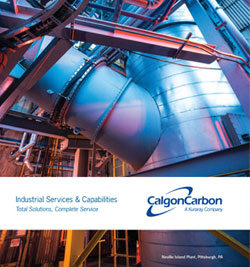Nuestro sitio web utiliza cookies, incluidas las cookies de perfiles de terceros, para mejorar su experiencia de usuario. Puede obtener más información sobre cómo utilizamos las cookies y cómo cambiar su configuración de cookies en nuestra Política de privacidad. Al cerrar este mensaje, hacer clic arriba o continuar utilizando este sitio, usted da su consentimiento para que utilicemos cookies.

Per- and polyfluoroalkyl substances, commonly referred to as PFAS, are emerging contamiants and environmentally persistent chemicals of growing concern. Many industrial operations who currently use, or have used these chemicals in the past, are being prompted to treat their wastewater or stormwater for these chemicals. Additionally, steps are being taken to address legacy PFAS sources in the environment.
There are challenges associated with PFAS removal, but Calgon Carbon has solutions. Taking a project from the laboratory, to pilot system, to full-scale treatment, we can assist with PFAS removal process development and provide the activated carbon materials and equipment to fully address PFAS sources. Our activated carbon products can be thermally reactivated by Calgon Carbon, destroying PFAS compounds, and the carbon returns to service.
Sign up for our mailing list to receive information about upcoming webinars and events relating to activated carbon solutions for PFAS removal in industrial applications, wastewater, and remediation.
Technologies/Solutions:

Activated Carbon and Equipment Products
Activated carbon is effective at removing many types of PFAS, including C4, C6, and especially the well-studied C8 compounds such as PFOA and PFOS. Although the choice of PFAS treatment technology depends on many factors, our FILTRASORB® 400 granular activated carbon (GAC) has proven an effective and reliable option for the removal of both short and long-chain PFAS. Our FILTRASORB® GAC is a reagglomerated GAC produced from bituminous coal, and has demonstrated superior PFAS-removal capabilities to coconut shell-based GAC. An example of the high performance of the FILTRASORB® can be seen in this case study.
GAC Reactivation Services
In addition to providing the GAC products and adsorber equipment for PFAS removal, Calgon Carbon also provides services to exchange spent carbon and reactivate the material, removing PFAS from the carbon and thermally destroying the PFAS in a high-temperature process. After reactivating the carbon it can be returned to service. Calgon Carbon’s Calgon Carbon this memorandum to describe our reactivation process and our understanding of its impact on the fate of PFAS.
If you have a specific project or inquiry relating to PFAS removal, please Contact Us now to reach your local Technical Sales Representative and discuss the specifics of your process.
Resources are available below pertaining to Calgon Carbon’s products, services, and experience with PFAS removal for industrial wastewater and remediation.
- «Keys to Tackling Industrial PFAS Treatment» WaterOnline article from Calgon Carbon
- GAC efficacy in treating short-chain PFAS
- Adsorber Equipment Brochure
- Case Study: PFAS Treatment at Eisleson AFB
- Webinar: Granular Activated Carbon – A Proven Solution for PFC Removal
- RSSCT Summary Report: Removal of Short Chain PFAS Compounds via GAC
PFOA & PFOS
Calgon Carbon's FILTRASORB® GAC can remove a wide range of concentrations of of PFOA and PFOS to non-detect levels. Our studies show that reagglomerated, coal-based GAC performs significantly better than coconut for PFOA and PFOS removal. Even if local regulations require lower PFAS concentrations than the EPA health advisory, GAC is an effective solution.
Más información >>Short-Chain PFAS
Coal based GAC, especially virgin material, effectively removes short chain PFAS effectively. Our reagglomerated bituminous coal-based FILTRASORB® GAC product, as well as our ion exchange products and services, will remove an array of PFAS including both long- and short-chain compounds.
Más información >>GENX
Reagglomerated coal-based GAC effectively removes GenX to non-detect levels.

